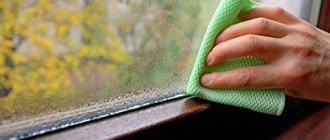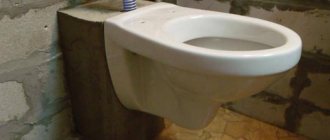Why do the corners in the house become damp?
The problem of damp corners and walls often worries both residents of high-rise buildings and owners of private houses. Due to the fact that the corner of the room is damp, the walls begin to darken, the wallpaper peels off, mold appears, and the air in the room becomes heavy. Plus, during the cold season, the temperature in the rooms drops, windows are opened less often to ventilate the room, a lot of precipitation falls, and the walls themselves are not dried by the sun's rays. Damp corners and walls are a fairly serious problem that should be addressed immediately. Damp indoors can cause various diseases and also become a gathering place for fungi and mites.
Read also: What to do if you are jealous
Therefore, the question of why the corners in the house become damp worries many.
Condensation after installing new windows
It happens that pockets of dampness appear in the corners of an apartment after replacing ordinary windows with plastic ones. The installed windows are very airtight; they tightly close the openings, as a result of which the ventilation of the room deteriorates. You can avoid damp walls in such cases if you know what to do.
Ventilation is often sufficient to exchange air in a room. However, if this is not enough, you can improve ventilation by installing an additional fan on the vent. Then the humidity in the room will decrease, and there will be no condensation of moisture on cold walls, in particular in corners where air exchange is reduced.
The problem of damp corners often becomes a concern during the cold season. Many people don’t even notice damp walls at first, but when the moisture turns into mold, the problem should be taken seriously. Constant dampness in the room causes fungi, mites and centipedes to multiply, and residents may develop various diseases, shortness of breath, cough, and allergic reactions.
Preventing the appearance of dampness
Following certain rules will help reduce dampness to a minimum and prevent its occurrence in the future.
- Laundry should be dried outside living rooms or with the hood turned on for air removal.
- When cooking, pots and pans should be covered with lids to prevent steam from escaping.
- In the bathroom, where the highest concentration of humidity is, as well as in the kitchen, hoods and ventilation openings should be regularly cleaned to remove excess debris, and these rooms should also be ventilated daily.
- In a private house, you can insulate the attic and also cover the walls with a waterproofing material, preferably with pores.
- All flammable substances that form a lot of moisture, in particular paraffin, should be used extremely rarely indoors.
- All rooms in the house should be ventilated daily.
- Correct errors in the heating system in a timely manner.
- Use a dehumidifier to reduce humidity. This household appliance can easily cope with the problem of dampness, and its compactness allows you to move the dehumidifier from room to room.
SEALING INTER-PANEL JOINTS
If it is necessary to work with the interpanel seam from the outside, if a leak is detected, it must be opened above the place where there is an area of high humidity on the wall. Moisture has the ability to seep into the smallest cracks, so this rule should never be neglected. At the same time, it is not always possible to detect an area where seam defects are clearly visible. In such cases, you simply need to lay a new insulating material in the joint, which in the future will serve as protection from moisture.
A leak in the wall can also be caused by the fact that the insulation has simply dried out and crumbled. Microcracks may also form in it. This may be caused by shrinkage of the building or due to the use of materials unsuitable for the existing climate.
Also, the joints of the plates can leak if the welding area is too close to each other or if the insulation is too dense. The problem may also arise due to the use of screed, the outer layer of which hardens after 24 hours, but the moisture inside can persist for more than one month.
Reducing humidity
If walls often get wet in interior rooms with high moisture (bathhouse, bathroom), then the problem is most likely in the ventilation system. Therefore, first of all, you should check the ventilation openings for the presence of unnecessary objects that may interfere with air circulation.
Read also: "Norm". Opera by Vincenzo Bellini
It’s easy to check how clogged the ventilation channels are: hold a burning candle to the vent and watch how the flame reacts: if it reaches towards the grate, then the channels are not clogged and there is a draft. When there is no flame response to ventilation, additional devices need to be installed in order to establish air circulation.
When the holes are not clogged, but the draft is still weak, additional slots can be made at the bottom of the door for air intake. If this does not help, a forced exhaust is installed in the ventilation duct. Such fans are turned on only when there are no people in the room, as they can seriously harm your health.
Experts advise installing fans with a built-in humidity controller in the bathroom. When humidity rises, the fan operates automatically, eliminating air oversaturated with dampness.
What to do
Having found out the reason why the walls get wet, the question arises of eliminating excess moisture.
If such a situation arose after renovation, then it is enough to ventilate the rooms more often. If this is a cold period of time, then it is important that the room is warm enough.
If the batteries are not enough, you can use additional heaters. When the problem lies in ventilation, you can try to remove foreign objects that interfere with normal air circulation.
Insufficient waterproofing is a more complex situation. Eliminating the problem consists only of finding the area where the water comes from and isolating it well. The main source is seams on the outside of the house. This task should only be solved by specialists.
A corner in the apartment is freezing, what should I do?
Freezing of a corner in an apartment
An apartment can be located in a building with different number of floors. Sometimes insulation is required at high altitudes. Then you need to contact specialists who work with equipment for climbers. An open exit to the roof of the house will be required, since this is how the equipment is attached and ropes with slings are lowered. The work of such specialists is dangerous and expensive. When the apartment is located on the 1st or 2nd floor, they often make do with scaffolding.
It is important! You cannot thermally insulate just a section of a wall, for example, just one corner. Then the problem will accidentally arise in a completely different place: where there is no insulation. Comprehensive work must be carried out.
The most correct step would be to insulate the outer wall, since internal work is unlikely to help. The dew point will simply shift, and condensation in the corner will form with even greater intensity. Sealants, internal insulation - all this is just a waste of money . Over time, it will turn out that it was still necessary to carry out external work.
Insulation of an apartment from the outside of the house
Is external thermal insulation always necessary? There are situations when the outer corner of an apartment freezes due to uncharacteristic reasons. This includes flooding and water leakage from neighbors. It is the upper corners that suffer from this. Then you need to contact the owners of the apartment on the top floor. Even if there is no constant flow of water, its leakage can occur almost unnoticeably: from a pipe, battery, etc.
Base
As for the above-ground part of the foundation, in addition to vertical waterproofing of the base, there is also horizontal waterproofing (to prevent capillary rise of water to the walls). This is done during construction using bitumen tape or special solutions.
If the walls of the first floor begin to become damp from below, it means that this protection no longer “works.” You can cut off the penetration of moisture by injecting a specially penetrating solution, which will fill the micropores in the base material.
To do this, holes are drilled along the perimeter of the house (below the floor slab level of the first floor) at an angle of 30 degrees to the ground level, in increments of 15 cm (7 pieces per 1 meter). They should not be through (5-8 cm to the surface). If there is access, for thick walls you can make a second row from the inside, offset from the first row. The sanitizing solution is pumped either using a special “syringe” or by gravity (based on the dropper principle).
In some cases, the cause of wet walls on the first floor may not be the capillaries of the base material, but the masonry joints of the foundation, if it is made of brick or blocks. Therefore, holes for injection of mortar must be made in the seams.
The problem of a wet foundation always exists, but more often it is encountered after winter. If there was a lot of snow, there will be a lot of water in the spring. As a result, meltwater floods the foundations of houses and accumulates underground.
Melting snow also causes groundwater to rise. And if you live in an area with their occurrence close to the surface, then the risk of flooding increases significantly. Therefore, at the end of winter, it is important to inspect the site and the subfloor of the house and drain melt water from the base of the building.
However, a snowy winter is not the only reason for a wet foundation. It may get wet due to:
- Violations of construction technology. The desire to save money is the main enemy of quality. Often, site owners decide to pour the foundation themselves, because the process does not seem too complicated, or they hire a team of handymen who have no idea about building regulations and technologies. This could end up becoming a serious problem. If you do not completely dry the concrete foundation of the house, cover it with waterproofing and immediately fill the barely set monolith with expanded clay, sand or other insulation, all materials will be wet. The moisture from them does not evaporate due to the screed; it will gradually rise, capturing the walls and floor. In addition, such a foundation will freeze in winter, since the water contained in it will crystallize, increasing the foundation in size. As a result, this will lead to cracks in the concrete foundation, internal and external waterproofing and an increase in the volume of water penetrating into the house.
- Break of communications in the basement. Often the communications of a house are concentrated in the basement. Water supply, sewerage, and heating pipes may run there. If they break, water very quickly fills the underground, and at the same time penetrates into the foundation. Unfortunately, simply pumping out the liquid is not enough; it is necessary to do high-quality drying.
- Absence or improper design of storm drainage system. Seasonal precipitation can significantly damage the foundation of a house. If there are no storm drains, or they cannot cope with the flow, the water is not drained away from the house, but accumulates at the foot of the house.
- Other reasons causing moisture accumulation at the bases of buildings.
If you encounter one of these problems, immediately call the dehumidifier team of Sinus JSC. The consequences of flooding must be eliminated as soon as possible. Call +7 495 681-73-61, we are always in touch!
Why is there mold, dampness and cold in the house?
To increase the “lifetime” of insulation against condensation (read the service life of the insulation), various technologies for ventilated facades are being developed. The purpose is for ventilation of the insulation.
Only an attentive reader can tell. If condensation “goes through the wall into the insulation,” then it simply will not allow it to dry. In which he will be absolutely right.
We must fight the cause, not the consequences...
Moisture accumulates in insulation – there is also air there. And it has its own temperature. And water wins, not with ice, but with steam!
The walls are getting colder . The owner of the house begins to heat more and more, maintaining the temperature in the leaky house. The condensation process becomes more intense. When you don't heat, the house is damp and cold. Mold on the walls is just around the corner. Or constantly drown - money down the drain.
Useful tips
A few additional recommendations to help protect your apartment or house from dampness:
- Use a hydrometer. In the warm season, the optimal humidity will be from 30 to 60%, the maximum - 65. In late autumn, winter, early spring, humidity should vary between 30-45% and not exceed 60.
- Provide access to the sun's rays.
- Ventilate the apartment; this must be done systematically and efficiently.
- Seal cracks in walls and floors.
- Provide high-quality waterproofing.
- Use fans, including exhaust fans, in the kitchen and bathroom. Periodically check the draft in the ventilation system. Check the condition of the plumbing equipment, paying special attention to the pipe connections.
- Systematically inspect the seal on plastic windows and replace it with a new one in a timely manner.
- When making major repairs, use mineral-based building materials. This will make it possible to effectively regulate the humidity in an apartment or private house.
You can eliminate dampness in your apartment in simple and accessible ways. Treating the walls with special compounds will destroy mold and prevent its reappearance. Systematic prevention will protect against increased humidity and fungus formation.
Will dense insulation help against dampness in the house and mold on the walls?
Now let's look at expanded polystyrene and polyurethane foam (PPU).
Excess moisture can also condense on their surface.
Where should she go in the face of such a powerful obstacle? It makes no sense to ventilate them using this technology.
Even a first-grader understands that it is impossible to “blow out” foam and polyurethane foam.
Moisture from their surface can only be “blown away” by ventilation, preventing the formation of condensation on their surface.
According to SNiP II-3-79, PSBs and PPU have vapor permeability. It is comparable to a stone. This means that a wall insulated on the outside with PSBs or PPU also “breathes.”
But it does not require any ventilation.
Now we need to move smoothly and learn to distinguish and not confuse air permeability with vapor permeability.
“...From the point of view of the diffusion process, the most rational sequence of wall layers is one in which the resistance to heat transfer decreases, and the resistance to vapor permeation increases from the outside to the inside .”
Guarantee for work done
Legal entities that contact us receive a guarantee for all work performed for a period of 5 years. In this case, the complexity and volume of work done does not matter. In the case of individuals, the warranty period is from 2 years.
The difference in the warranty period is that order volumes for legal entities are always higher. For individuals, after the expiration of the warranty for the work performed, there is the possibility of preferential maintenance of the building. As for the estimated service life of the materials, it is 15 years.
Factors indicating a problem
It is possible to determine a significant excess of the humidity level in an apartment not only using a special device, but also visually.
Mold and mildew appear on the ceiling or walls. Microorganisms multiply at lightning speed in a confined space when the moisture content in the air exceeds 70% and the ambient temperature exceeds 18 degrees.
Mold on the walls
Symptoms of dampness include problems with the condition of the finish: plaster may fall off, wooden materials may rot, or wallpaper may come off the walls.
Condensation appears on plastic windows. The reason may be either manufacturing defects in the structures or problems with the microclimate in the apartment.
Condensation on plastic windows
In addition to the listed problems from dampness in the room, for those in the apartment discomfort will also be caused by an unpleasant odor, which cannot be eliminated with the help of any air fresheners.
Excessive indoor humidity
The simplest reason, in terms of elimination, is high humidity in the apartment.
It is possible that the appearance of pockets of dampness was preceded by the replacement of windows in the room. New windows closed the openings more hermetically and worsened the ventilation of the room. In some cases, in order to avoid dampening the walls of the apartment, it is enough just to ventilate the room more often. If this is not enough, or the problem occurs in a room with potentially high humidity, for example, a kitchen, then you can try to improve the quality of ventilation. To do this, you can put a fan on the vent. Thus, ventilation will turn from natural into forced supply and exhaust with greater productivity.
A corner in a brick house is getting damp, what to do?
Contents of the page In houses or apartments, a situation often arises when corners or walls begin to become damp.
As a result, the wall darkens, the wallpaper begins to peel off, and a characteristic smell of dampness appears in the apartment. Such consequences do not add to the attractiveness of the room. But besides this, a damp surface in a room is an ideal environment for the development of mold.
And fungal spores are the cause of the occurrence and development of numerous respiratory tract diseases. What is the reason for the appearance of moisture on the surface of the walls, and how to deal with this problem? What causes dampness in an apartment?
The reasons may be: The cause of dampness may be external moisture falling on the walls and penetrating through microcracks or poorly sealed seams inside. More often, such a nuisance is typical for apartments on the upper floors with a poor-quality drainage system, for walls along which drainpipes run, as well as panel houses with poorly sealed joints between the slabs.
Where to contact
If all possible options for eliminating dampness do not help, then you need to write and submit a statement to the management company. It is drawn up in writing and in two copies. The paper should contain detailed information about when the corners or walls began to get wet, and an exact indication of the location.
ATTENTION! After submitting your application, it is important to ensure that it is recorded. The applicant must keep one copy with a mark.
The next action of the management company should be to send a technician to inspect the residential premises, based on the results of which a report on the presence of dampness and the reasons for its occurrence will be drawn up. The apartment owner must request a copy of this document.
As soon as the act is drawn up, the management company must decide on the option for repair work, as well as the time frame by which it will be completed. It is advisable for the apartment owner to take a copy of each document. If the repairs are not carried out or the period is significantly delayed, then these copies can be contacted with the relevant authorities.
The floor and wall in a private house are damp
A certain level of humidity is always present in the house: washing, cleaning rooms, washing and even cooking. But you need to make sure that the humidity does not rise above normal.
The presence of excess humidity in a private home means not only wet walls, moldy corners, unpleasant odors and damaged furniture, but also dysfunction of the respiratory system, allergic diseases and other medical problems. How to determine the optimal humidity level in the house? This is done using a hygroscope. The optimal indoor air humidity for comfortable living is considered to be 40–60%. Exceeding this indicator is fraught with problems in the form of condensation, musty air and fungus.
Video - How to eliminate freezing of corner walls?
If a corner of your house freezes , the following guide will help:
- It is the façade that needs to be insulated, not the inside of the wall. If a house has many defects in the form of cracks and gaps, then heat-insulating plaster cannot be used.
- The brickwork is embroidered and filled with mortar. As a rule, such plaster contains polystyrene foam granules. It expands and fills empty pores.
- Next, you can begin covering the facade with cladding material. It is also often thermally insulating.
It all depends on what exterior finishing (siding) is chosen. There are quite a lot of materials that have an aesthetic appearance.
Which insulation to choose
An example of the technology for insulating an external wall.
As soon as the defects of the brick wall are eliminated, you should begin to decorate it externally. It will serve as insulation and a solution to the problem of freezing corners for many years. The same applies to panel houses. They are also insulated, no matter what floor the apartment is on, although here the choice of materials is limited.
Not every siding is suitable for a panel or multi-story building, since the finishing material must fit into the architecture of the house and not disturb it. The entire list of insulation materials is given in the table.
Table 2. Types of insulation for exterior decoration of a house:
| Name | Description |
| Thermal insulation plaster | Most often used for exterior decoration. It has a high vapor permeability rate, so condensation will not form inside the home. Contains particles of polystyrene foam, not sand. |
| Liquid thermal insulation | Acrylic-based compositions, whose properties are identical to mineral wool insulation. Apply in 1 or 2 layers. Such liquid insulation may also contain antifungal components. Thanks to them, mold will not form in the corners. The composition is quickly applied. Adheses well to almost any surface. |
| Thermal panels | This includes siding and sandwich panels. The latter are finished in the form of decorative bricks, imitation of the texture of natural stone and other options. Thermal panels are applied directly to the external wall. Sometimes a frame of profiles is pre-assembled. The material is easy to cut and quickly attached to the surface. No additional preparation required. |
| Mineral wool | A classic insulation method that is gradually becoming a thing of the past. There are a lot of ways to do this type of finishing. For example, first the mineral wool itself is laid along the wall, then corrugated board or siding is attached on top. |
The usual polystyrene foam is also used, on top of which a layer of plaster is applied. This is a cheap method of insulation, used not only in brick, but also in panel houses. In the latter, it is used much more often, since it allows not to disturb the overall appearance of the house. Different thicknesses of foam are used, which determine the degree of insulation. When performing work, it is important to eliminate gaps between joints. Otherwise, cold air will pass through them.
Prices for thermal insulation materials
Thermal insulation materials
The walls in a private house are getting damp, what to do - How to eliminate dampness in the corners of the house?
- The main causes of dampness in a private home
- 1
- Poor air ventilation
- What to do
- Where to contact
- Causes of damp walls in the apartment and corners in the rooms: ways to combat mold
- what to do with moisture, where to go, why corners become moldy, what makes a window wet Why does this happen External moisture
- Eduard Guest
- Similar articles
- What should the humidity be?
- External moisture
- Eduard Guest
- Presence of a cold surface
- How to remove dampness from walls
- Eduard Guest
- Presence of a cold surface
- Similar articles
- Simple useful tips
- How to get rid of dampness in the house - follow the main rules!
- 1
How to make waterproofing plaster
Wetting of the building wall can be prevented with special drying plasters. This is a fairly simple and cheap method that significantly increases the waterproofing of walls. Drying plasters can be used for interior and exterior decoration.
The material for it is most often silicates with a microporous structure, which does not allow salts to penetrate into the plaster, but rather to crystallize deep in the wall. Because of this, moisture cannot rise above the level of the wall, however, without blocking its natural evaporation.
When running the process:
- Drying plaster can be applied to old plaster, brick, or existing mortar. The material is used at any stage when finishing the wall:
- during the first plastering;
- when leveling walls;
- for waterproofing.
- The wet layer of existing plaster and an additional approximately 50 centimeters of dry base are removed. For plastering, the surface must be smooth, free from cracks and chips, and delamination must not be allowed.
A clean, slightly rough base is ideal.
- Before application, the wall is moistened with water and then primed.
- Special plaster is laid, like regular plaster, in a layer 2–4 centimeters thick.
Advice: Drying plaster should be used with vapor-permeable decorative finishing materials, such as paper wallpaper, silicate fabrics. Good ventilation must be ensured in the area being treated.
How and with what to putty a wet wall, how to protect your home from moisture, all the methods of performing the work are shown in the video in this article.
Is it worth insulating from the inside?
Insulation from the inside - is it necessary when a corner freezes
? Sealant, insulation, putty, thermal insulation - whatever the owners of apartments and houses use to get rid of the problem with a frozen corner. Even having reached the wall itself from the inside, it is not enough to seal its cracks. Internal insulation won't help either. All this helps extremely rarely when the corner freezes just a little.
It is important! The vast majority of experts recommend insulating a house or apartment from the outside, not the inside. Then you can solve the problem completely and eliminate its causes. Internal thermal insulation and other work will only give a temporary effect.
Of course, you can try to insulate your home from the inside, but, as a rule, this does not help and only increases the amount of costs. You will still have to do all the work outside, since this is the only way to eliminate the root cause.
Some nuances of sealing joints
If the tightness of the seams is broken and cracks appear in the walls, the corners in the room begin to become damp. In this state of affairs, there is only one way out: the waterproofing of the joints between the panels needs to be repaired, and microcracks in the walls need to be repaired.
After high-quality sealing, the walls should not gain moisture. They can become damp and leak only when the technology for sealing the seams is broken.
The main mistakes are applying sealant without prior repair or using a low-quality sealant.
This should also be taken into account: if waterproofing of joints is carried out in one apartment, and not in the whole house, then the problem of dampness will not disappear. Moisture will penetrate into poorly sealed seams in an apartment on the floor above or on the technical floor, so although more slowly, it will find its way into the desired room.
Foundation waterproofing
It happens that dampness in the house is caused by the fact that the foundation is poorly insulated. If its waterproofing is insufficient, groundwater when raised above 1.5 m can penetrate into the walls. In this case, they will get wet, mold will appear under the baseboard and in the corners, the plaster will begin to fall off, and the wallpaper will deteriorate. However, if horizontal waterproofing of the foundation is done correctly, it can prevent the penetration of groundwater.
Why does the foundation get wet?
Why do the walls in a private house become damp?
/ / 944 Views Contents A frequent problem for many residents of private houses is dampness that forms on the walls and in the corners of houses.
This can cause more serious problems. From banal mold and mildew to the destruction of part of the wall.
To prevent this from happening, it is necessary to notice the problem in time and begin to deal with it. And to successfully combat such an unpleasant phenomenon, you need to correctly determine the cause.
In general, all reasons for the formation of dampness on walls can be divided into external and internal. It depends on which side of the house the problem is on. An example of an external cause would be water entering through cracks in the walls during the rainy season.
Internal causes include those located indoors. This may be poor ventilation of the house or its absence, the presence of fungus in finishing materials, or insufficient heating of the premises.
This classification is rather conditional.
Damp wall
Dampness on the walls can appear for several reasons. The main indicator of dampness in a wall is mold. A damp wall is formed from three main reasons:
- External leaks
- Poor thermal insulation
- Lack of ventilation
Dampness on the walls creates a favorable environment for the growth of mold and creates an unfavorable environment for human habitation. The main negative factors of damp walls in a room are:
- Heat leakage and increased energy consumption for heating a room with damp walls.
- Active reproduction of fungal and mold spores.
- Decreased immunity and exacerbation of chronic diseases of the human body due to uncomfortable temperature and humidity conditions in the room and the active reproduction of fungal and mold spores.
Our specialist will help you correctly determine the cause and give further recommendations - how to remove dampness from the walls and how to treat the walls against dampness. Determining on your own the reasons why your wall is damp, without the appropriate equipment, can lead you down the wrong path of further action. Savings on diagnostics will definitely affect your wallet, since any construction work to eliminate dampness in our time is not very cheap.
Why do corners freeze in a brick house?
Why does a corner freeze in a brick house?
A brick house differs from a panel house in the materials used in construction. Many believe that it is much more environmentally friendly and warmer, but this was not the case. It all depends on the quality of the brick and the work itself on laying it. Even in a brick house with thick walls, corners can freeze.
Causes:
- Insufficient number of masonry layers.
- Incorrect ligation of bricks in the corners.
- Poor quality material used.
- A high percentage of wear and tear of the entire house, including emergency condition.
Even if a brick house was built quite recently, it cannot be ruled out that cold and moisture will appear in its corners. The builders could have laid out the brick incorrectly and used insufficient quantities of it. The influence of climate should not be ignored either. If the region experiences low temperatures, then laying in one layer will clearly be insufficient. Then the corners will be the most vulnerable area.
Freezing of a corner in a brick house due to cracks
Damaged brick buildings, houses with a high percentage of wear and tear are the sector where problems always arise, including with corners. They freeze because of voids, crevices, cracks, and because of the cold coming from the roof. The situation here cannot be resolved by insulation alone. First, work is carried out to eliminate the same cracks or other defects.
Freezing due to cracks, reasons for their appearance
Photo of a crack in the wall.
Owners of brick houses may also face problems such as the appearance of various cracks - vertical, horizontal, oblique, cobwebs, etc. All this is the result of errors and miscalculations of the construction itself.
Depending on how the wall of a brick house cracked and the type of cracks, the main front of measures is determined that should stop their further appearance.
Existing cracks must be treated, since without carrying out the appropriate work, the process of destruction of the house will, although at different speeds, occur.
The reasons for the appearance of cracks may be the following:
- natural shrinkage of the house, the process takes 1-2 years;
- large load on the floors, due, for example, to a heavy roof;
- deformation of load-bearing beams;
- deformation of the foundation for various reasons, one of them may be a high level of groundwater and its uneven freezing/thawing or insufficient depth,
- as well as the influence of many other factors.
How to “read” cracks correctly
Photo of a crack in the base.
Most often, cracks are evidence of the so-called “shrinkage of the house.” Considering the overall weight of a brick structure, it is quite natural, but this is not always the reason. Violations of construction technology often have a greater influence on their appearance.
- The appearance of clear vertical cracks is evidence of problems with the foundation:
- insufficient depth for this structure;
- adverse effects on it from heaving or moving soils.
- Oblique cracks appear as a result of several reasons:
- subsidence of soils due to their heterogeneity;
- houses directed in a certain direction indicate a possible, although not yet outwardly noticeable, subsidence of a particular corner of the house;
- multidirectional, as a rule, indicate a multiplicity of places of ground subsidence.
- Horizontally oriented cracks appear, most often, due to a violation of the brickwork technology and especially due to the quality of the ligation of the rows. Their main manifestations:
- bending of window, door, beam ceilings;
- the critical moment is the extrusion of one of the ceilings, but in this case the insufficient strength of the ceiling itself is to blame.
- Horizontal arcuate cracks are the result of:
- heavy weight of floors;
- walls and (or) foundations that do not correspond to such ceilings.
- Vertical cracks can also appear in the masonry itself, usually at the junction of two buildings. The reason for this is the absence of an expansion joint. Their installation in such cases is mandatory in order to avoid the consequences of different shrinkage rates of the two combined buildings.
- Cracks may also appear due to some other reasons not related to the construction process, for example, lack of ebb for rain or other ingress of water onto the wall, into the micropores of the brickwork. This is especially dangerous in winter or during thaws, since at sub-zero temperatures, frozen water acts like a wedge, destroying the masonry. This type of crack is quite well recognized by its characteristic “path”.
- expansion from below - the ceiling puts increased pressure on the wall;
- expansion at the top of the crack - the foundation of the house settles on the corresponding side.
The cause of cracks can also be judged by their appearance:
Possible ways to eliminate cracks
Photo - repairing a crack.
Before choosing a method for eliminating and sealing cracks, it is necessary to conduct a test aimed at determining the current state of the structure, whether the process is ongoing or has already stopped.
For this purpose, special control marks are used: the date of their installation is recorded on a paper tape and monitoring is carried out for several months. If the tapes do not break, then the shrinkage process or other processes have stopped, and new cracks most likely will not appear.
And if on the contrary, then you will have to find the reason for their appearance in order to develop an appropriate work plan.
If the crack no longer has a tendency to expand or increase, it is sealed with heat-insulating material and plastered. For a tiled facade, partial relaying of bricks may be necessary to restore the aesthetic appearance of the house.
And if the tape breaks, then based on the time during which it happened, as well as the type and direction of the break, a preliminary cause is determined, followed by a more thorough study of all factors.
The solution to the problem will most likely be one of the following:
- the use of metal conductors to fasten the wall masonry;
- relaying part of the wall, if technically possible;
- you can use a method to lengthen the load-bearing wall or strengthen the internal ones, which will give additional strength and immobility to the structure;
- partial remodeling with measures to strengthen the foundation is the most difficult and costly way; doing everything with your own hands will not work here; you will need advice and help from specialists. In addition, you may need to use special equipment.
External moisture
The cause of dampness can be external moisture falling on the walls and penetrating through microcracks or poorly sealed seams inside. More often, such a nuisance is typical for apartments on the upper floors with a poor-quality drainage system, for walls along which drainpipes run, as well as panel houses with poorly sealed joints between the slabs.
moisture in corners
In order to eliminate the problem, it is necessary to clean the wall of the old coating, re-plaster it from the outside, prime it, cover it with waterproofing mastic, and only then completely paint the resulting surface. You can independently carry out such a cycle of operations either in a private house or on the first floor of an apartment building. In other cases, solving the problem of damp walls on your own will be very problematic due to the need to carry out high-altitude work. Therefore, you will have to turn to professionals.
Some ways to eliminate freezing symptoms
The photo shows the search for the cause of freezing.
You should not immediately take measures to insulate the room - simple insulation, especially from the inside, will not give practically any effect, but will only shift the dew point, and the moisture will condense elsewhere.
For example, cold air will come into contact with warm air indoors. And this will significantly worsen the situation.
Advice. The problem is identified, as a rule, in the cold season, but it must be solved in the warm season, when it is possible to thoroughly dry the house as a whole and problem areas in particular.
The best option:
- sealing seams;
- thermal insulation of the facade;
- thermal insulation of the foundation.
Although thermal insulation of the facade is unlikely to be possible if the facade is lined with decorative or facing bricks. In this case, the only way out is to carry out internal insulation work.
Although their effect is much lower, if they are performed correctly, this will solve the problem associated with freezing of corners and walls.
Insulation and insulation of problematic walls and corners inside the house
The photo shows complete protection of the wall from cold and dampness.
If a problem appears in the house after all the finishing work has been completed, most likely you will have to do the repairs again, since cosmetic measures will not give results.
The following work needs to be done:
- remove wallpaper, plaster;
- unstitch the seams;
- treat seams and walls with antifungal compounds;
- The next serious operation is how to dry a brick house, that is, dry the walls and the room itself . For this, it is best to use heat guns, but household heating devices can also be useful;
- re-fill seams, voids or cracks that have appeared with polyurethane foam, liquid foam compositions, you can use so-called “warm” types of plasters , which contain particles of expanded polystyrene, which have high heat-insulating properties;
- cleaning treated seams and surfaces and preparing them for plastering work;
- performing plaster, most often several layers are required, for the first, again, you can use the same “warm” plasters , but you can also use regular plasters, but with the addition of hydrophobic additives, the instructions detail how to use them;
- Additionally, you can apply a layer of liquid insulation with excellent adhesion characteristics . Outwardly, it resembles paint and is applied with a roller or brush. In addition to its main function, it has both antifungal and anti-corrosion characteristics, which allows this material to be used, for example, for anchoring ventilated facades, significantly eliminating the effect of “cold bridges.”
"Dew point" in the wall of the house
In construction terminology there is such a well-known concept as “dew point”. This fearsome design point, the potential meeting point of cold and heat, is located somewhere inside the structures. If the dew point is calculated incorrectly, condensation forms at the boundary of the temperature difference. Such places are usually called “cold bridges.” They can appear as a result of improper installation of architectural elements, anchors, deformation elements, ruptures of the thermal insulation layer, or due to banal errors in thermal engineering calculations.











